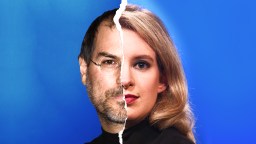Underdog stories can inspire us to greatness (or to break the rules)

- Underdog stories can inspire groups to achieve their goals.
- Leaders can use such stories to craft a collective identity that increases motivation, well-being, and creativity.
- However, when used improperly, the same basic story can also justify bad behavior and foment outgroup bias.
We all tell stories about who we are. Consider any simple “I am” phrase: “I am a parent,” “I am a writer,” “I am a survivor,” or “I am a hard worker.” Within such sample-sized autobiographies, you’ll find a narrative crafted to express identity, the meaning of someone’s experiences, or their relationship to the world. The same is true when we construct collective identities in the form of businesses, societies, and cultural groups.
“Story is essential. It’s who you are, what your mission is in the world, why you do it, and what you aspire to do,” Beth Comstock, former vice chair of GE, said in an interview. “I always urge companies, in telling their story, you’re trying to create that relevance, that connection. You’re carving just a little tiny piece of yourself into someone’s brain.”
But leaders need to take care not only to tell their story; they must consider how they tell it. Told one way, a story can motivate a group to band together, build cooperative relationships, and achieve the improbable. Told another way, the same basic narrative structure can lead people to cheat, foment outgroup bias, and even break the law. And we can see this contrast in the classic underdog story.

Everybody loves a good underdog story
One may think an organization would want to project an image of achievement and superiority over its competition. This isn’t always the case. According to a systematic review published in The Academy of Management Review, when facing disadvantages, a leader may want to reframe the organization’s struggles using an underdog story. That’s because a collective identity built around underdog membership can motivate people and instill in them the confidence to reach their goal.
For that to work, however, the story must incorporate certain key elements. According to the review’s authors — Logan Steele, an associate professor at the USF Muma College of Business, and Jeffery Lovelace, an associate professor at the University of Virginia — those are:
- A shared sense of disadvantage: a set of circumstances that makes it difficult for a group to achieve its goals.
- A shared understanding of the aspirations: an understanding and agreement on what the group needs to achieve.
- A sense of collective efficacy: a belief that they can achieve their aspirations.
Bonus points if the leader telling the story is a credible underdog, and external cues, such as news stories or market analyses, confirm the leader’s message.
Steele and Lovelace point to the Philadelphia Eagles’ historic Super Bowl LII victory as a classic example. The team entered that year’s playoffs with their starting quarterback, Carson Wentz, suffering a season-ending knee injury. Commentators saw this as a devastating blow; a disadvantage compounded by the fact that their opponents, the New England Patriots, were enjoying a record number of Super Bowl appearances. Rather than deny these setbacks, head coach Doug Peterson used them. He depicted these misfortunes in terms of a rousing David-versus-Goliath narrative.
And it worked. The franchise rallied around the goal of winning the championship and their ability to do so. Some players identified so strongly as underdogs that they took to wearing dog masks as a symbol of their status. It helped that Peterson himself was a credible underdog with a history of facing long odds and securing the win.
“All groups have an identity, and usually, it is up to the leader to shape it. A powerful way leaders shape a group’s identity is through the stories they tell.
Logan Steele
It’s not always good to be the king
Steele and Lovelace point to many potential advantages of a collective underdog identity. To start, refocusing on what a group can achieve together — instead of the long odds — can boost member motivation. An underdog identity can also increase acceptance of creative risk-taking to make up lost ground.
For example, when Steve Jobs returned to Apple in 1997, the company was bleeding millions of dollars a quarter. The situation was so dire that commentators suggested the company shutter its doors. Instead, Jobs and chief design officer Jony Ive dedicated their efforts to innovation. This led to the successive hits of the iPod, iPhone, and iPad in the ensuing decade.
An underdog identity can boost group members’ well-being, as well. When an organization focuses less on external difficulties and instead on what it can control, it reduces the sense of helplessness and stress among its people. This was the strategy Paul O’Neill employed when he became the CEO of Alcoa in 1987. He steered the enfeebled company away from focusing on its market competitors and toward safety. He pushed factories to reduce workplace injuries to zero. When he left the company in 2000, its net income was five times larger.
“As a result of perceived status differences as more malleable, underdogs will perceive a higher level of control over their environment and their ability to achieve their desired outcomes,” Steele and Lovelace write. “Individuals who hold this belief generally have higher well-being and greater resilience to stressors.”

The underside of the underdog story
However, underdog stories can become pernicious if leaders aren’t careful. For example, instead of creativity, the risks taken by group members may evolve along the lines of cheating, lying, sabotage, and all manner of rule-breaking. This turn is more likely when the leader preaches that the disadvantages facing the group are interminable and intractable. Such risks may not only be tolerated but can be amplified through “risk creep.”
Consider Uber. The ride-share company has long projected itself as a rebellious underdog — despite its vast market share. It also has a rap sheet that includes working hard to skirt regulations and stealing intellectual property, as well as a litany of cultural and legal controversies.
“When you frame success as a zero-sum game, you motivate members of an organization to sabotage their competition. The message is that we’re being treated unfairly and are at a disadvantage, so people may try to level the playing field by cutting corners,” Steele said in a press release.
And while a little healthy competition is acceptable, if the us-versus-them narrative becomes too entrenched, it can lead group members to intensify outgroup bias. “While crafting a sense of ‘us’ and ‘them’ is necessary to establish a collective identity, a bias against ‘them’ is not,” the authors write.
Finally, underdog stories may diminish group well-being if the change necessary to reach the group’s aspirations is so radical it creates a lack of control that is stressful and overwhelming.
The power of story
The underdog story is a ubiquitous narrative structure across cultures; it’s appeared in everything from Greek mythology to American sports movies. We even cast historical figures in the role, such as George Washington and Genghis Khan. This familiarity helps make underdog stories powerful leadership tools.
As such, Steele and Lovelace’s review serves as an important reminder to leaders of all kinds: We must not only attend to the stories we want to tell but their potential consequences. Unlike Aesop’s Fables, our stories don’t come with neat-and-tidy morals at the end. They’re messy, roundabout, and open to interpretation. You do a service to yourself and your people when you take that into account in your telling.
Learn more on Big Think+
With a diverse library of lessons from the world’s biggest thinkers, Big Think+ helps businesses get smarter, faster. To access Big Think+ for your organization, request a demo.





